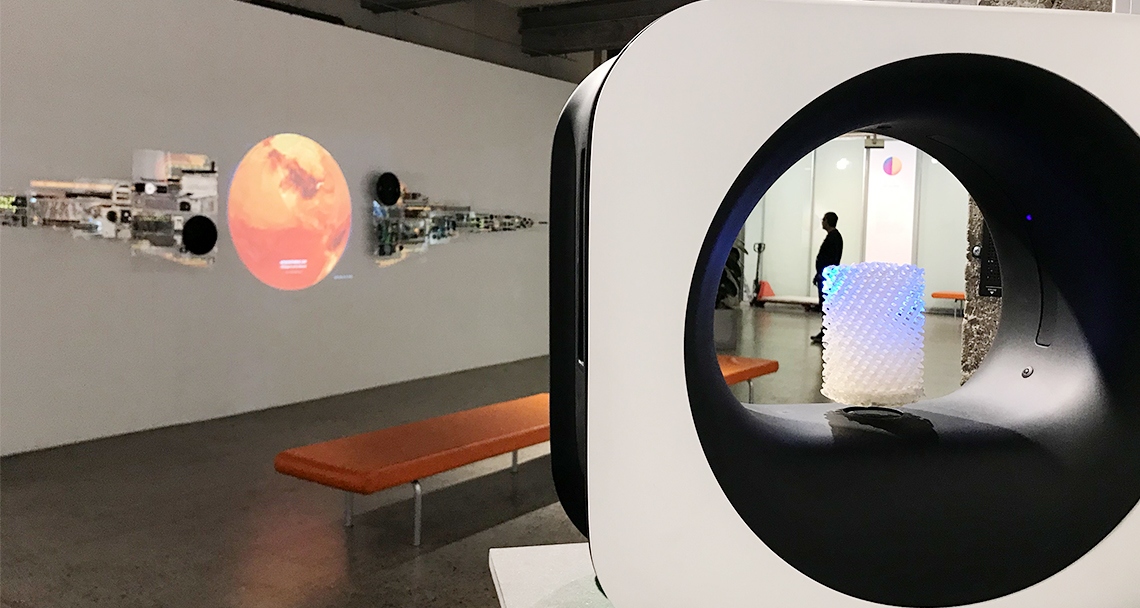Virtual tour of the ReFuturing Exhibition
Get at 360 virtual walkthrough of the ReFuturing exhibition and watch the replay of the seminars.
ReFuturing Exhibition 360 Virtual Walkthrough
Replay of the seminars
1. Futures: designing for a ReFutured Paradigm
The first theme questions 'Futures as we forecast it', by bringing together different approaches towards futuring and asking how we explore the radically alternative futures that go beyond the narrow trajectory of our present paradigm. Can we dare to realise collective futures worth living in?
Presenters: Andrew Merrie, Bodhisattva Chattopadhyay, Jomy Joseph
Moderator: Josina Vink
Watch Webinar Recording
2. Climate Change: designing for Societal Transformation
The second theme questions 'Climate Change as we act upon it', by discussing what it implies to change the change, why we haven't been able to bend the emissions curve and how design can modify its toolset to be equipped for exploring how we enter a more long-term sustainable trajectory.
Presenters: Isaak Stoddard, İdil Gaziulusoy, Linda Schneider
Moderator: Anders Ese
Watch Webinar Recording
3. Development: designing for Real Progress
The third theme questions 'Development as we know it' by asking how to design for 'real progress' and what that might entail and require for human and planetary well-being. With that we also ask how we can reclaim this goal by designing for essential needs of the many rather than enriching the affluent few.
Presenters: Kris De Decker, Nick Stevens, Håkan Edeholt
Moderator: Rachel Troye
Watch Webinar Recording
Read more about the design projects at the exhibition

biomA
Composite energy fabrication device
The Open Tech society and the Citizen Science movements in Sau Paulo develop biomA, a 3D volumetric printer that ‘grows’ organic batteries and supercapactors from algae and chitosan biopolymers instead of the violently mining minerals for batteries. The system sequesters carbon dioxide from the atmosphere by ‘nurturing’ Cladophora algae which then are precision levitated ‘acoustically’ as a highresolution 3D volumetric point cloud using an array of ultrasonic transducers. The algae ‘seeds’ are then sprayed with a chitosan binder and each layer is formed using a UV laser that cures the biopolymer. The combination of the chitosan coated algae in a computationally generated structure makes for a highly versatile, closed loop sustainable battery. This volumetric fabrication method would go on to create many opportunities for scaling out renewable energy infrastructure such as optical solar structures.
Reference:
Aioki, I., Zenlin, P., & Cadogan, M. (2131). Glocal Energy Cultures: Realising 22nd Century Radical Indigeneity and Beyond in The Open Journal of ReFuturing, Open Design Society

Biomineralisers
Symbio-metallurgical processes and Biomining
Biomineralisers become a means to refine rare earth minerals from their ores using biological processes of biomining and bioleaching. Biomineralisers also apply these methods combining them with wastewater electrolysis for bioremediation of toxic effluent sites left behind after centuries of mineral exploitation. Together with biochemical processes of microbial growth, the bioactive carbon medium provides for a proven, effective, and cheap means to clean up nitrates, phosphates and heavy metals from freshwater ecosystems. The yield quantities are low but are in sync with the needs for a slow fabrication processes that become the norm for many goods. Certain strains of fungi and species of plant organisms which have been known to biologically leach minerals from ores are applied here, working together with metabolic systems. In addition to copper and gold production, biomining can also be applied in local scales to refine elements such as cobalt, nickel, zinc, and uranium. Biomining has also been applied in the processing of sulfide and uranium ores which show remarkable opportunities for remediating of soils and water bodies.
Reference:
Jaladas, R., Konpa, T., & Chowdhury, M. S. (2131). Beyond Vaporware: Remembering the Blue Reparations Programs in
The Open Journal of ReFuturing, Open Design Society
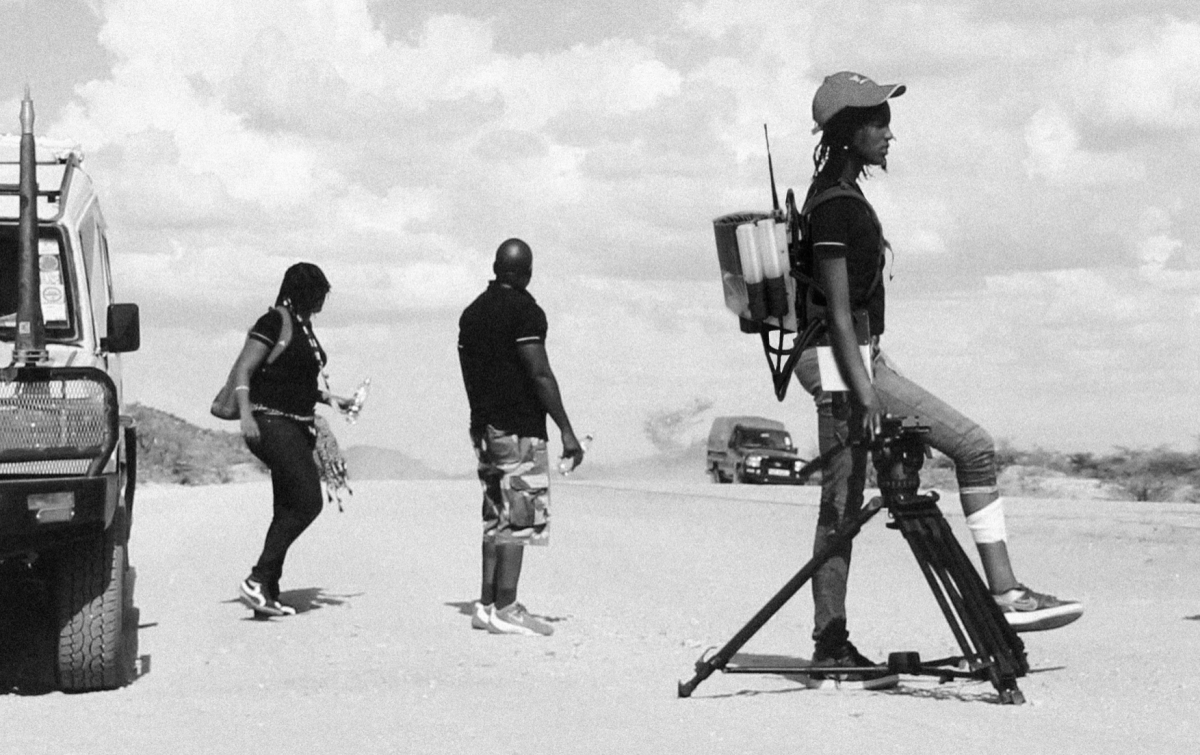
The Walezi wa msitu
Guerrilla Agroforesters of the Mombasa Climate Resilience Zone
With the adoption of Climate Resilience Zones (CRZs), replanting and reconnecting of old growth forests world helped revive terrestrial biodiversity and for a long carbon drawdown. In Mombasa CRZs were first established by guerrilla agroforesters in secret who used forest seeding devices that use ‘seed balls’ to establish new, old growth forests in the far reaches of the surrounding regions. They used seed balls with a carbonised medium ‘supercharged’ with nitrogen and phosphorous from biological sources. Furthermore, the carbonised biochar medium is also inoculated with mycelium spores that are aid in establishing old growth forests, further enhancing the availability of nutrition rejuvenating the soil microbial health linking resource sharing root networks of plants to the old soils, spreading out mycorrhizal networks. These seed balls being spread across in a randomised patterns using ‘creative’ forms of seeding old growth forests which offer far more resilient forms of biodiversity recovery. These forest seeders are used to restore the soils and regenerate terrestrial ecosystem services, complementing conservation efforts including biomass production from agriculture and forestry, storage, filtration and transformation of nutrients and water; biodiversity habitats; raw material sources and carbon sinks. Such practises have been compared to the well-known indigneous ‘Terra Preta’ soils from the Amazonas.
Reference:
!Kweiten-ta-||kwain & Mei, L. S., (2131). Becoming Terrestrial: Of Climate Resilience Zones,
Symbiotic Fabrication and Ecosystem Regeneration in The Open Journal of ReFuturing, Open Design Society

Firefly (螢⽕蟲)
Autonmous Seeders of Old Growths used at Regeneration Festivals
Over time, Climate Resilience Zones (CRZs) get expanded using autonomous seeding devices called Fireflies. The citizen science groups in the Hong Kong CRZs, inspired by the Walezi wa msitu take the concept of the old-growth seeding to the next level with automation and carry out more effective regeneration processes.
These autonomous seeders are cheekily called 'fireflies' (螢⽕蟲) in a period when
insect declines with the 6th mass extinction are still a serious cause for concern. Under the hothouse conditions and unpredictable climate cycles, these assisted seeders offer the possibilities for migrating and regenerating vulnerable terrestrial ecosystems to suitable climates zones, by regenerating soils and freshwater ecosystem through human hands in the various regeneration festivals that become popular. In the 21st century, one can see these ‘fireflies’ busy planting new old growth ecosystems in regions where the heat death of forest ecosystems have occurred. However, this is only done under desperate attempts to preserve biodiversity and relieve these ecosystems of climate stressors as disruptive climate patterns play havoc with ecosystems the world over.
Reference:
!Kweiten-ta-||kwain & Mei, L. S., (2131). Becoming Terrestrial: Of Climate Resilience Zones,
Symbiotic Fabrication and Ecosystem Regeneration in The Open Journal of ReFuturing, Open Design Society
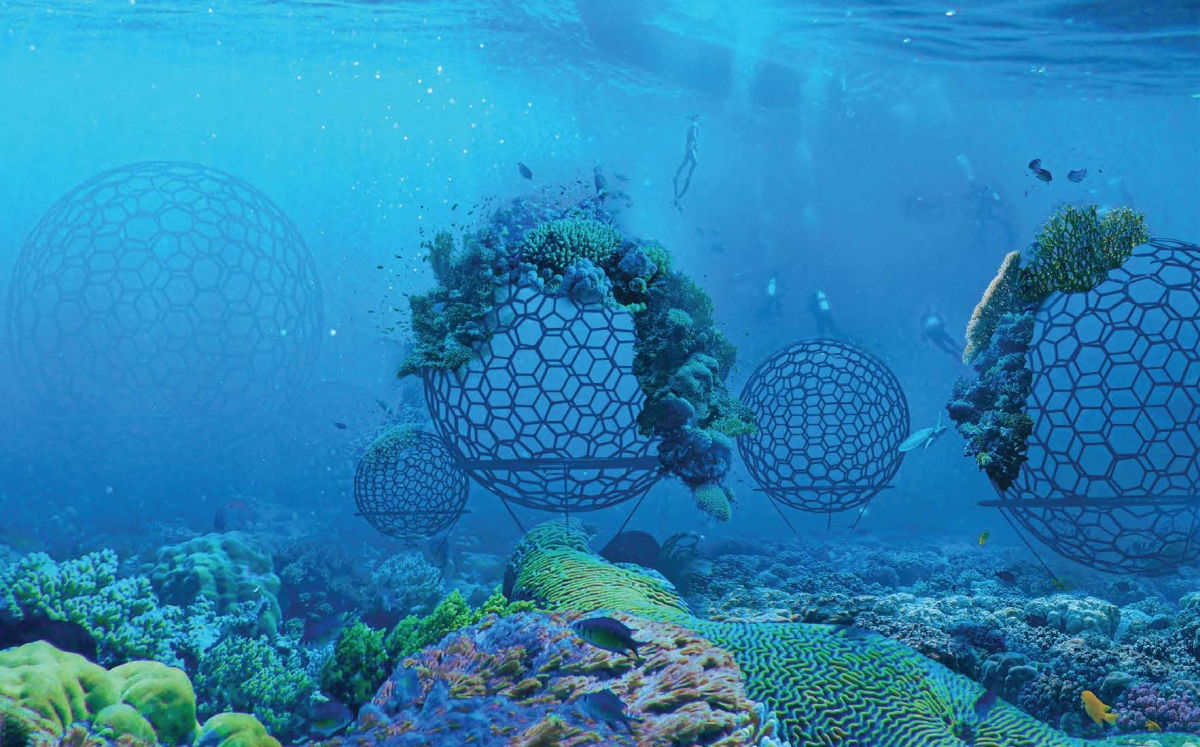
Kalo Probal
The Electric Black Coral of the Sundarbans
The implementation of mangrove-coral sea walls is designed to provide protection from intense hurricanes and more energetic storm seasons in regions most vulnerable to climate extremes by absorbing the energy and from the subsequent storm surges and sea level rise. These ecosystems like the climate resilience zones (CRZs) on land are meant to rehabilitate coastal communities by stemming storm energy but also provide sanctuary for corals in order to survive bleaching events, revive fisheries and sustenance to coastal communities while also reviving marine biodiversity. These electrified reefs however are made from cathodic deposition of aragonite which can be used as architectural material which make possible highly resilient and accelerated artificial reefs scalable. Known as the “biorock” method, it was showing possibilities for recovery of coral reefs at incredible rates even if damaged beyond repair by combining with traditional ‘seeding’ and coral nurseries and aid in rapid recovery.
Reference:
Jaladas, R., Konpa, T., & Chowdhury, M. S. (2131). Beyond Vaporware: Remembering the Blue Reparations Programs in
The Open Journal of ReFuturing, Open Design Society
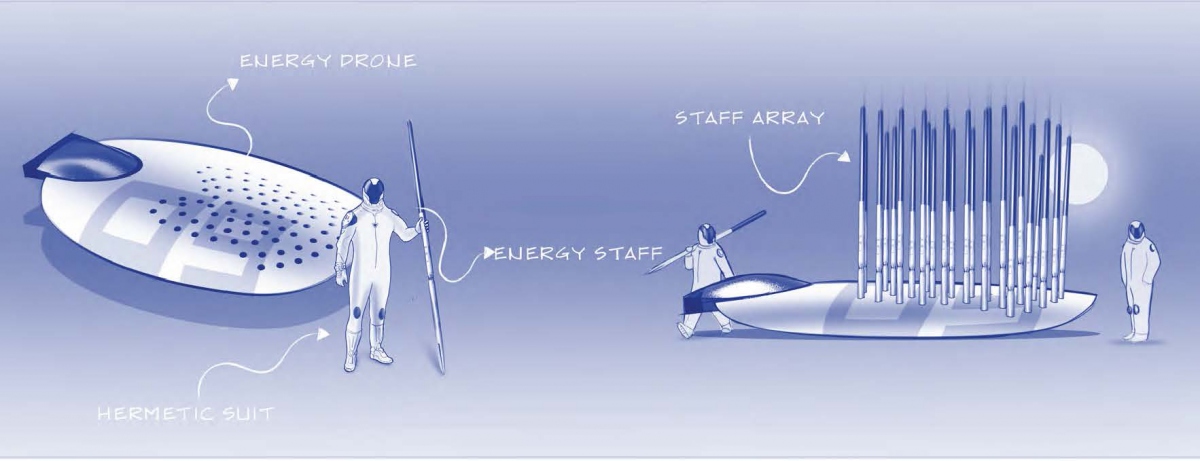
Masisi Energy Cultures
Energy Rituals of the Masisi People
The indigenous traditions in energy cultivation of the Masisi people is based on the technical adaptation of integrating fiber optic solar cells coated with graphene along with a fungal microbial fuel cell (MFC) that feeds off radioactive soils. The mycelial properties are also applied to their radiation shielding suits. The cell structures of the staff and the arrangements are based on ‘hierarchical biomimetics’ inspired from the naturally occurring optical structures such as the glass sponge and in hairs of polar bears. The indigenous community focusses on applying myco- remediation for cleaning up the radioactive soils in their regions and the mycelium are also able to produce energy from radioactive sources.
Reference:
Aioki, I., Zenlin, P., & Cadogan, M. (2131). Glocal Energy Cultures: Realising 22nd Century Radical Indigeneity and Beyond in The Open Journal of ReFuturing, Open Design Society

Rainmakers
For Harvesting Atmospheric Rivers and Artificial Glaciers
Rainmakers are structures composed of autonomous modular/woven structures that act as moisture accumulation devices which work on solar radiation alone They are meant to offer a last-ditch effort for harnessing moisture from atmospheric rivers and redirecting it to provide access to freshwater where it might be needed as rainfall becomes precarious for agroforestry needs and even used to build receding glaciers and polar ice caps with Ice Stupas. These Ice Stupas which are being implemented in the Himalayas may offer glimpses of possibilities given new cultural practises of replenishing and expanding new glaciers could emerge were they to be incentivised and linked to community action which perhaps would be better suited for local resilience. Rainmakers themselves advance these practises with advanced biological fabrication methods and materials, tuned for using biomimetic principles and even some techniques of harvesting water from these atmospheric rives and electric field propulsion for navigation.
Reference:
Jaladas, R., Konpa, T., & Chowdhury, M. S. (2131). Beyond Vaporware: Remembering the Blue Reparations Programs in
The Open Journal of ReFuturing, Open Design Society
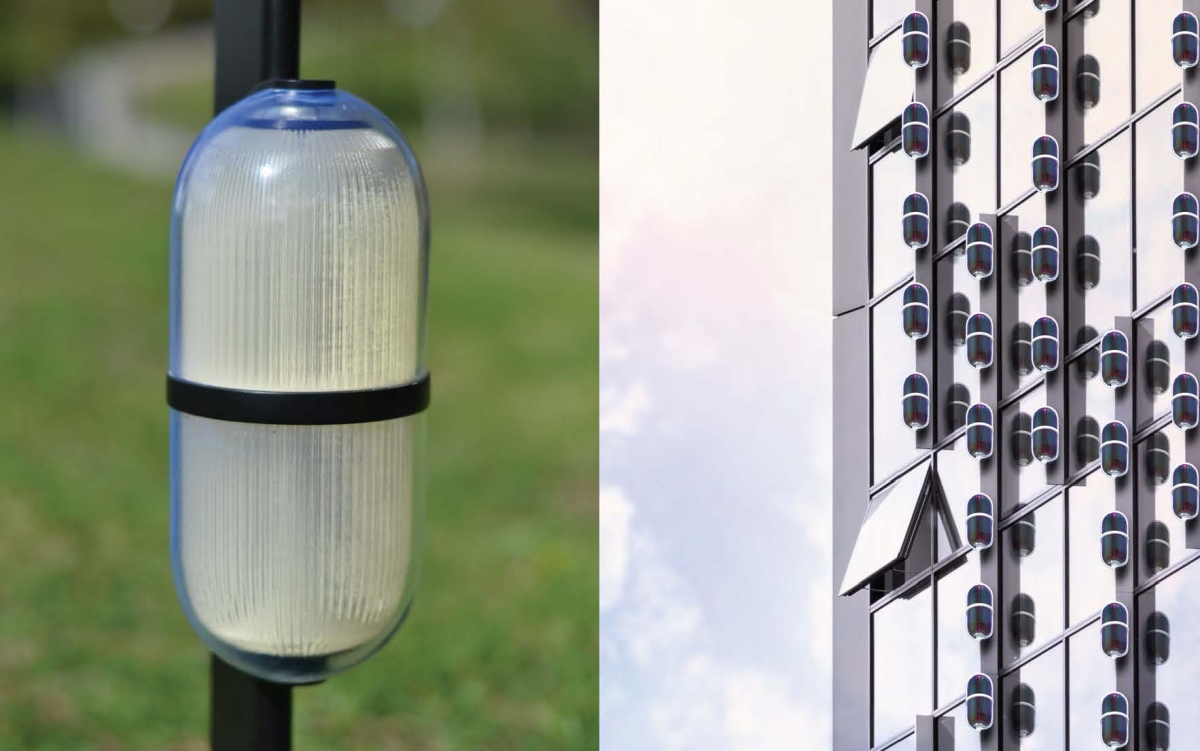
Volumetric Solar Structures
Morphogenetic Photovoltaic solar cells
Volumetrically fabricated solar structures become possible with development of biomA fabrication systems. These new types of morphogenetic solar cells directly convert thermal and visible spectrum of solar radiation with the help of optically tuned structures coated with photovoltaic perovskite aerosol inks. These cells are also contained within a thermally insulated volume of phase-change solutions that extend their thermal efficiency by utilizing infinitely cycling through thermo- electrical conversion cycles for energy storage and use. This helps in redirecting captured solar radiation for adequate purposes when possibilites of incident solar energy are low, such as nighttime or winter sun. With this the urban envelop becomes a net generator of solar energy when coupled with drastic declines in overall energy consumption.
Reference:
Aioki, I., Zenlin, P., & Cadogan, M. (2131). Glocal Energy Cultures: Realising 22nd Century Radical Indigeneity and Beyond in The Open Journal of ReFuturing, Open Design Society
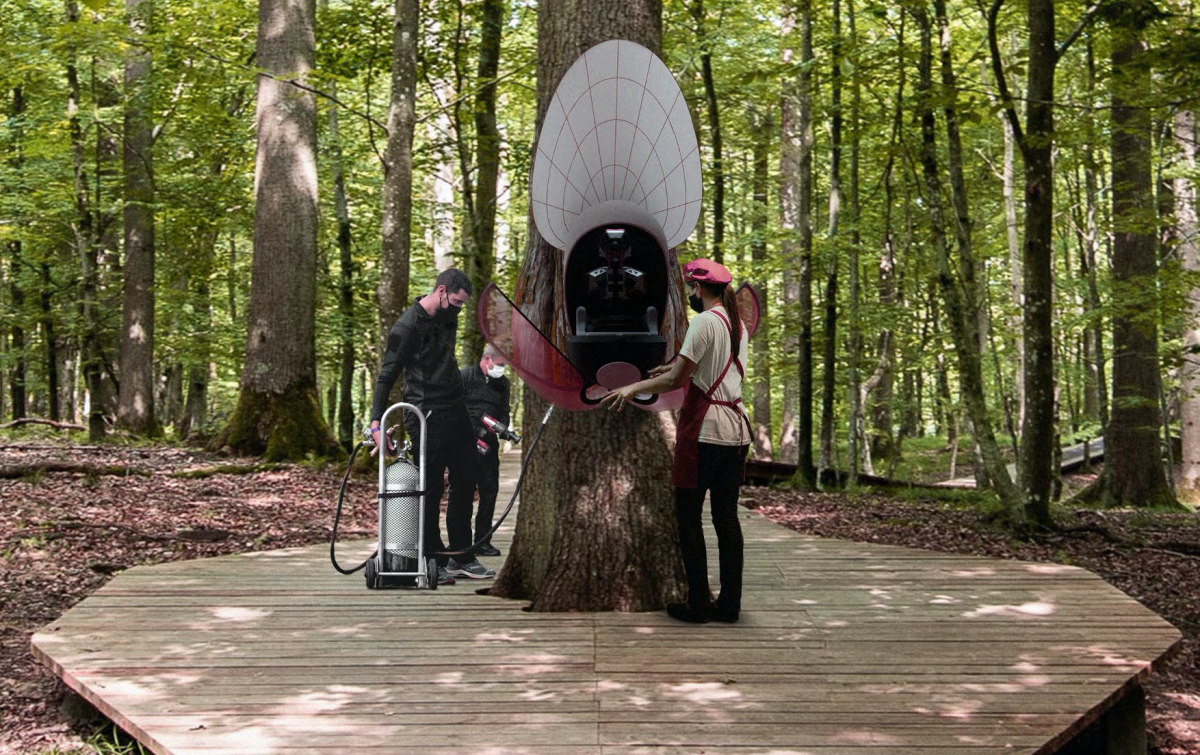
Symbiotic Fabrication Pods
Symbiotic Mutualism in the Pan-Indigenous Autonomous Zones
The SymFab pods allow for localised, ecological forms of hi-tech production and consumption of advanced composites using “symbiotic manufacturing”. The carbonisation of organic matter and fibres are applied to create effective replacements of high-performance composites from organic sources for socially useful fabrication systems which are carbon sequestering by integrating into local industrial production for advanced technological applications. The pyrolytic carbonisation of these natural fibres when processed as bio-composites produced from organic fibres with in situ processing of plant-based resins that can even be used to create high clay based ceramic electrodes. Much of this is also possible with biomimetic forms of ‘symbitronic computational interfaces’ which mediate the interactions between these fabrication infrastructures to maintain and nurture the ecological processes.
Reference:
!Kweiten-ta-||kwain & Mei, L. S., (2131). Becoming Terrestrial: Of Climate Resilience Zones,
Symbiotic Fabrication and Ecosystem Regeneration in The Open Journal of ReFuturing, Open Design Society
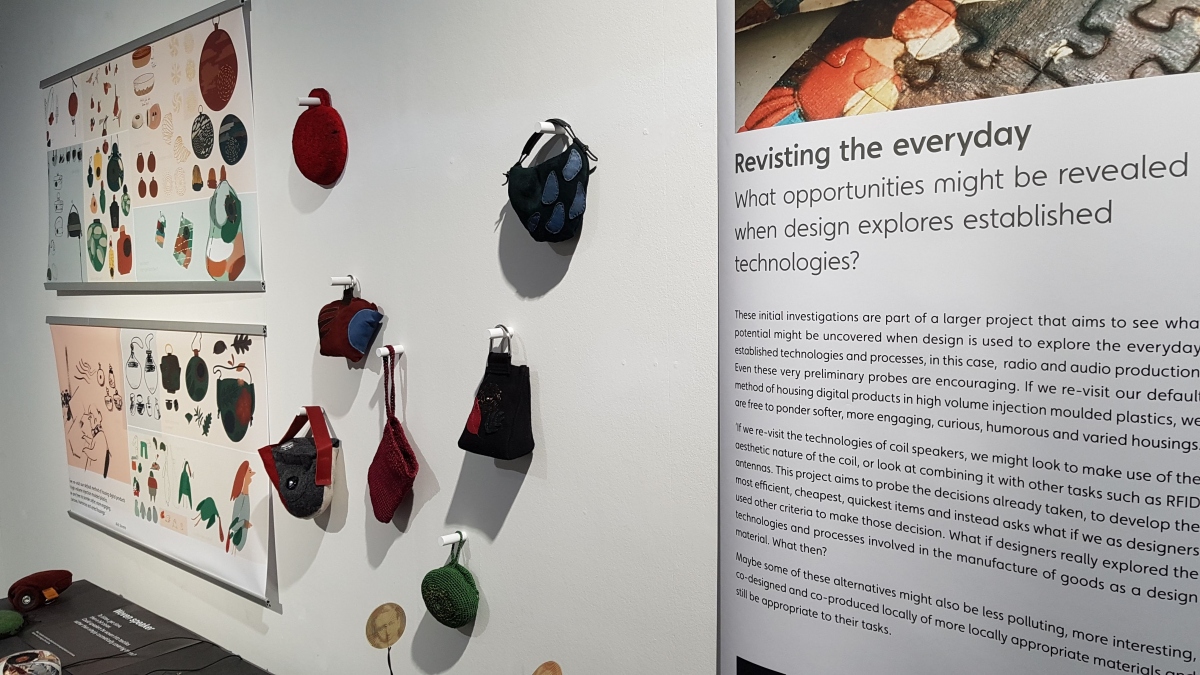
Revisiting the Everyday
What opportunities might be revealed when design revisits everyday technologies?
These initial investigations by Mosse Sjaastad and Nick Stevens are part of a larger project that aims to see what potential might be uncovered when design is used to explore everyday, established technologies and processes, in this case, radio and audio production. Even these very preliminary probes are encouraging. If we re-visit out default method of housing digital products in high volume injection moulded plastics, we are free to ponder softer, more engaging, curious, humorous and varied housings. This project aims to probe the decisions already taken, to develop the most efficient, cheapest, quickest items and instead asks what if we as designers used other criteria to make those decision. What if designers really explored the technologies and processes involved in manufacture of goods as a design material. What then? Maybe some of these alternatives might also be less polluting, more sustainable, produced more locally of more diverse materials and still be appropriate to their tasks.
